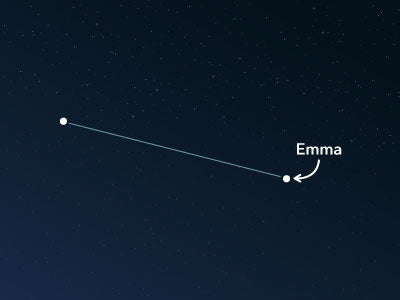The constellation Antlia
Características
- Nome latino
- Antlia
- Hemisfério
- Hemisfério Sul
- Visibilidade
- December - July
- Área
- 239 deg²
- Estrela mais brilhante
- α Antliae (HIP number 51172)
- Especialidades
- Galaxies

The Antlia, Latin, and Greek for Pump, symbolizes an Air Pump. It is an inconspicuous constellation in the southern sky that was defined only in the 18th century. Antlia contains only a few deep-sky objects, none of which can be observed with the naked eye.
Hemisphere, visibility, and area
The constellation Antlia can be seen between 49° N and 90° S and is visible from all regions of the southern hemisphere. North of the equator, it is visible only from places such as Paris in France, Vancouver in Canada, or Kiev in Ukraine.
In the southern hemisphere, the constellation is visible for more than six months a year, from December to July. For northern regions, the best time to observe the constellation is from February to May. At this time, it is low above the horizon.
Antlia covers an area of approximately 239 square degrees, making it the 62nd largest constellation among all 88.
Most visualizations of Antlia connect two or three stars to form a line. These are the main stars in the constellation but are not particularly bright. The brightest of them is the star α Antliae (Alpha Antliae), an orange giant located approximately 366 light-years away from earth with an apparent magnitude of about 4.22.
The inconspicuous shape and faint stars make it challenging to locate Antlia in the night sky. Therefore, it can be helpful to orient oneself using nearby constellations such as Hydra, Pyxis, Vela, and Centaurus.
Specialties in the constellation
In the area of Antlia lie some faint galaxies. However, special equipment, such as a telescope or binoculars, is needed to observe them.
The Antlia Cluster, also referred to as Abell S0636 is a group of roughly 234 galaxies situated in the Hydra-Centaurus Supercluster. It is the third closest cluster to the Local Group, following the Virgo Cluster and the Fornax Cluster. The cluster lies in the southeastern part of the constellation and includes the giant elliptical galaxies NGC 3268 and NGC 3258 as the primary members of a subgroup to the south and north.
The spiral galaxy NGC 2997 becomes visible through a powerful telescope. It was discovered by the German-British astronomer William Herschel in March 1793. Its distance from the Milky Way is estimated to be roughly 39 million light-years. With an apparent magnitude of roughly 10.6, it is the brightest galaxy in Antlia.

A barred spiral galaxy can also be observed. It bears the catalog number NGC 3001 and was found by the British astronomer John Herschel in March 1835. Its distance from the Milky Way is estimated to be 100 million light-years.
History
After the invention of the telescope, Nicolas Louis de Lacaille, a French astronomer, measured the positions of numerous stars from the Cape of Good Hope near Cape Town in South Africa. During this survey, he found that there were still some undefined areas of the sky. So he introduced a variety of new constellations.
Unlike most constellations from ancient Greek times, which often bear the names of mythological figures, Lacaille's naming was inspired by the latest technological innovations.
That is how the constellation Antlia, known as the Air Pump, came into existence. The inspiration for this name was the invention of the vacuum air pump, which in the 17th century made it possible to study the physics of gases.
In today's depictions, the air pump can no longer be recognized in the constellation. Over the centuries, the visualization has been adapted multiple times during its transfer to new star maps, resulting in significant differences between the earlier and more recent depictions.
PublicadoLeia mais artigos interessantes

An overview of all 88 constellations
Learn more about all 88 constellations and read interesting information about the mythology, visibility, and features.

Aplicativo Planetário
Descubra o céu noturno com nosso aplicativo de planetário!
Disponível para iOS e Android.

Nomeie uma estrela na constelação Air Pump
Name a star in a constellation and create something that lasts for eternity.